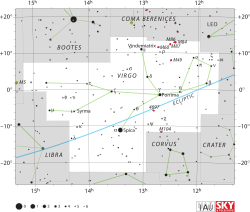Virgo (constellation)
| Constellation | |
 | |
| Abbreviation | Vir |
|---|---|
| Genitive | Virginis |
| Pronunciation | /ˈvɜːrɡoʊ/, genitive /ˈvɜːrdʒɪnɪs/ |
| Symbolism | the Virgin |
| Right ascension | 13 |
| Declination | −4 |
| Quadrant | SQ3 |
| Area | 1294 sq. deg. (2nd) |
| Main stars | 9, 15 |
| Bayer/Flamsteed stars | 96 |
| Stars with planets | 29 |
| Stars brighter than 3.00m | 3 |
| Stars within 10.00 pc (32.62 ly) | 10 |
| Brightest star | Spica (α Vir) (0.98m) |
| Messier objects | 11 |
| Meteor showers | Virginids Mu Virginids |
| Bordering constellations | Boötes Coma Berenices Leo Crater Corvus Hydra Libra Serpens Caput |
| Visible at latitudes between +80° and −80°. Best visible at 21:00 (9 p.m.) during the month of May. | |

Virgo is a zodiac constellation which lies on the celestial equator. It is between Leo (at west) and Libra (at east).This constellation is large; the constellation is the second biggest constellation you can see on the sky. Legends say Virgo is Astraea.
What you can see there[change | change source]
Virgo's most briliant and important star is Spica (α Virginis). This star helps to see Virgo. Other important stars are Zavijava (β Virginis), Porrima (ν Virginis) or Auva, also called Minelava.
Deep-sky notable objects[change | change source]
Because there is a galaxy cluster (the Virgo cluster) within its borders, this constellation is especially rich in galaxies.
- Messier 87, one of the biggest elliptical galaxies discovered, with a supermassive black hole, the first black hole imaged.
- Messier 49, The brightest galaxy in the Virgo Cluster
- NGC 4526, with NGC 4984. They are lenticular galaxies .
- Eliptical galaxies M59 and M60. M60 has a partner to the north (NGC 4647).
- Quasar 3C 273, very difficult to see.
- IC 1101, one of the largest galaxies known.
Wikimedia Commons has media related to Virgo (constellation).
